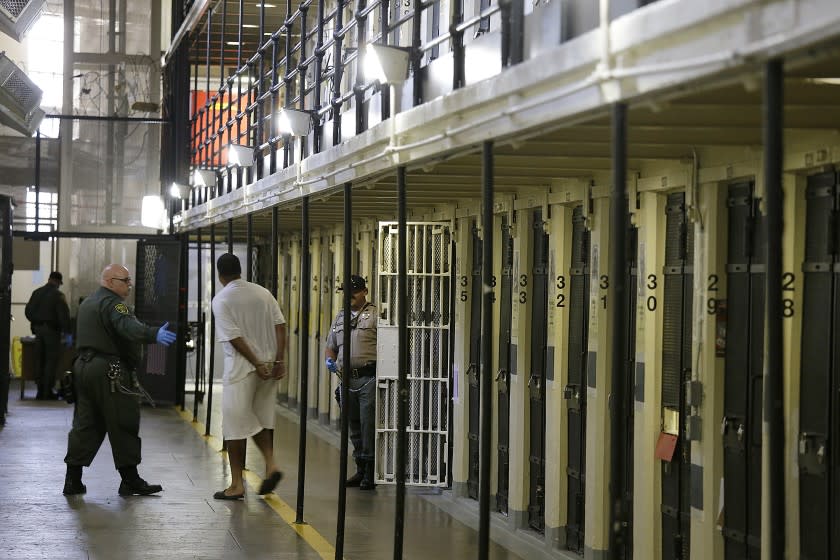Column: California's Supreme Court should stop 'tinkering with the machinery of death'

- Oops!Something went wrong.Please try again later.
My opposition to the death penalty dates back to a single week in the early 1990s.
As a young reporter working on a story about New York’s capital punishment laws, I called more than a dozen district attorneys in counties all around the state. I was, at that point, unsure what to think about the death penalty, but I was stunned when, one after another, they told me — off the record, because none dared antagonize voters — that they did not believe it had any deterrent effect whatsoever.
Most murders, they said, are committed in the heat of a passionate moment, often by people who are drunk or high or mentally ill. The murderers aren't calculating the consequences of their acts.
For me, that was transformative. Even later, when I learned more about exonerations, about the racism baked into the system and about the moral arguments against executions, it was always that first realization that had the most profound effect on me.
If prosecutors don’t believe in its effectiveness, why should anyone else?
It was a little more than a year later that Supreme Court Justice Harry Blackmun wrote his now-famous dissent in Callins vs. Collins, in which he concluded: “I no longer shall tinker with the machinery of death.”
“I feel morally and intellectually obligated simply to concede that the death penalty experiment has failed,” Blackmun wrote. “The problems that were pursued down one hole with procedural rules and verbal formulas have come to the surface somewhere else, just as virulent and pernicious as they were in their original form.”
Yet here we are nearly three decades later, and courts around the country are still tinkering. Right now, for instance, there’s another case before the California Supreme Court that, if it goes the right way, could make the death penalty a bit less unfair.
But it will not make it fair.
The case involves Don’te McDaniel, who was found guilty of two murders after a gang-related drug dispute in South Los Angeles in 2004. As is required for a conviction under the law, the jury reached its verdict unanimously and beyond a reasonable doubt.
In the subsequent sentencing phase of the trial, the jury found that there were “aggravating circumstances” that justified imposing the death penalty. But the jury was not required to agree on each specific aggravating circumstance unanimously before it could be considered, nor was the jury instructed that its final determination of death had to be decided beyond a reasonable doubt. McDaniel’s lawyers say they should have been; the state attorney general’s office disagrees.
The stakes are significant because if McDaniel’s sentence is reversed, many other cases involving death row inmates could also be affected.
Now I’m not saying that McDaniel’s lawyers are wrong. If we’re going to put people to death, we should by all means require unanimity about the reasons the death penalty should be imposed, and jurors should be required to reach their final determination beyond a reasonable doubt.
But in my view, the court ought to go a whole lot further.
The fact is that the death penalty is so wrong — so arbitrary, capricious, unreliable, racist, ineffective and immoral — that it borders on dishonest to pretend we can smooth over its problems with case-by-case fixes.
The court should instead take the opportunity — in this case or in one that comes before it soon — to issue a broad opinion deeming the death penalty unconstitutional and banning it in California altogether.
The piecemeal approach isn’t working.
Just look at the kinds of cases courts have heard over the last two decades since Blackmun’s dissent. Should we execute minors? Should we execute people who are developmentally disabled or mentally ill? Should we allow execution methods that cause suffering? Should we allow defendants to be put to death because their lawyers were incompetent or because a filing deadline was missed?
Of course we shouldn’t do any of those egregious things. But by continuing to address these flaws one by one, the courts help persuade people that there are ways to fix what is in fact an unfixable system.
The problem, as Justice Blackmun realized 27 years ago, is that no sooner does one inequity get addressed than another materializes.
The electric chair was supposed to be more civilized than the gallows, but now we consider it barbaric. Even the lethal injections that replaced the electric chair are now often viewed as cruel and unusual punishment.
It was great that in 1987 the U.S. Supreme Court ruled that no one under 16 could be executed. But the court was back in 2005 to rule that no one under 18 could be executed.
At some point a reasonable society has to say: Enough is enough. Band-Aids and Scotch tape are not sufficient.
I don’t want to belabor the familiar arguments. Suffice to say, as others have noted before me, that the United States doesn’t punish rapists with rape, nor does it burn down the houses of arsonists. So why do we believe the proper punishment for heinous murderers is death?
Our society remains utterly confused about the death penalty. Consider its history here in California: The state Supreme Court struck it down in February 1972, declaring it “cruel and unusual punishment” and commuting the sentences of everyone on death row. It was reinstated later in 1972, abolished again in 1976, reenacted in 1977, reaffirmed in 1978, and there have been several close-call efforts to abolish it again since. In 2016, state voters rejected Proposition 62, which would have repealed the death penalty. In 2019, Gov. Gavin Newsom instituted a moratorium on executions that remains in place while more than 700 condemned prisoners live on death row.
It’s time for the state Supreme Court to do away with capital punishment in California.
@Nick_Goldberg
This story originally appeared in Los Angeles Times.

